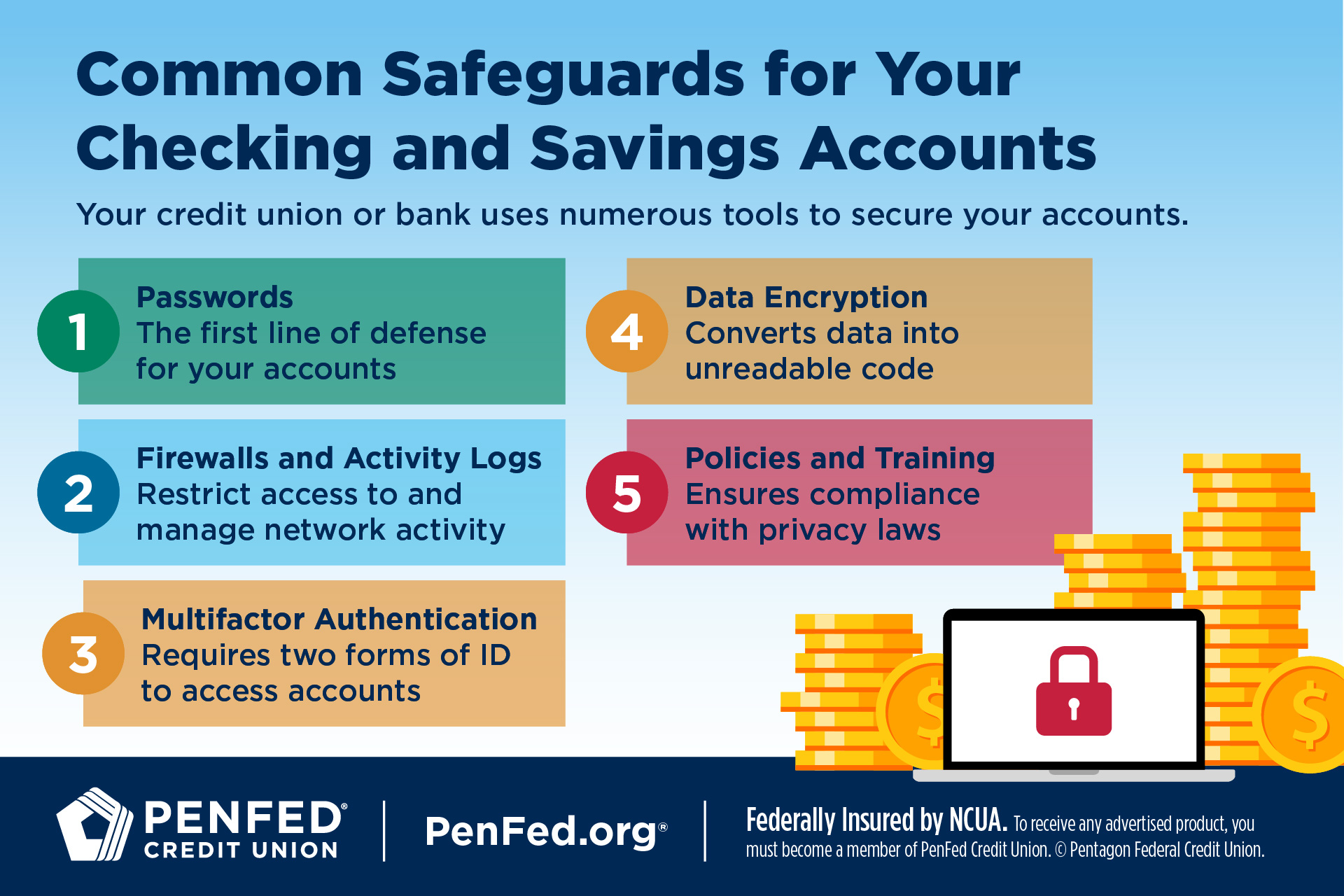CHECKING & SAVINGS
Is Your Money Safer in Checking or Savings?
EXPECTED READ TIME:5 minutes
From old-school bank robberies and heist movies to the age of mobile deposits, virtual finances, and cybercrime, you might be wondering just how safe your money is.
Fortunately, if you have a checking or savings account (or both), your money is far safer at a credit union or bank than what often plays out on the silver screen.
In fact, financial institutions go to great lengths to protect your cash and keep it out of the hands of modern-day bandits.

General Safety With Checking and Savings Accounts
In the traditional sense, checking and savings accounts are both incredibly safe places to keep your money.
The National Credit Union Administration (NCUA) automatically guarantees accounts up to $250,000 for each member of a federally insured credit union. Meanwhile, the Federal Deposit Insurance Corporation (FDIC) offers the same level of protection for customers who have money in checking accounts at FDIC-insured banks.
So, if your credit union or bank were to go belly-up or was robbed the old-school way — both of which are highly unlikely, mind you — you’d be covered, dollar-for-dollar, up to the $250,000 limit.
It’s worth noting that neither type of federal insurance covers financial losses caused by cybercrime. That’s where protection from your credit union or bank kicks in.
Checking Account Security
Not surprisingly, the financial services industry has emerged as one of the top targets for cyberthieves, with the sector experiencing a 238% increase in cyberattacks in the first half of 2020 alone. The methods preferred by hackers: phishing and ransomware attacks.
Despite the exponential rise of cyber threats on credit unions and banks, a checking account remains one of the most secure places you can keep your hard-earned dollars.
A checking account remains one of the most secure places you can keep your hard-earned dollars.
Is It Safe to Keep Money in a Checking Account?
Truth be told, the biggest security threat you’ll face with your money in a checking account is a lost or stolen debit card. If either wound up in the wrong hands, a thief could potentially use your card for purchases or attempt to access your account online before you have time to notify your credit union or bank. You might enjoy protection provided by the Electronic Funds Transfer Act (EFTA), but how much protection you get depends on when you contact your institution.
Your best bet is simply to act fast: check your account regularly and contact your credit union or bank immediately if something appears wrong.
The biggest security threat you’ll face with your money in a checking account is a lost or stolen debit card.
What Types of Security Do Checking Accounts Provide?
There’s not a lot your credit union or bank can do to prevent you from losing your debit card or having it stolen. However, financial institutions provide multiple layers of security to help protect your checking account from being hacked and to limit unauthorized use of your debit card. Common security features and tools include:
Passwords. The first line of defense in protecting your checking account from online fraud is your password. A strong, unique password or passphrase that you update frequently and don’t reuse for other accounts can go a long way in keeping cyber thieves at bay.
Firewalls and activity logs. Most credit unions and banks have firewalls that restrict access to their networks, which ensures only authorized personnel are logging into their servers. They also maintain and monitor activity logs to identify suspicious activity.
Multifactor authentication. Most credit unions and banks require multifactor authentication, a security feature that requires a second form of identification before allowing you to access your checking account online. This added layer of security may prompt you to enter a PIN, answer a security question, or provide biometric identification (fingerprint, facial scan, etc.).
Data encryption. Financial institutions use encryption software to convert your personal data and transaction information into code that only they can read. This prevents hackers from intercepting and using data from your credit union or bank’s network.
Policies and training. The Gramm-Leach-Bliley Act requires financial institutions to maintain and enforce policies that protect their consumers’ personal data and account information. Credit union and bank employees also receive training to ensure they adhere to federal and state privacy mandates and to learn how to detect and prevent internal and external fraud.
Although digital tools and security features provide a solid foundation for account protection, the safety of your assets ultimately depends on you. Following best practices for online security will help to protect your checking account from unauthorized access and use.
Financial institutions use encryption software to convert your personal data and transaction information into code that only they can read.
Savings Account Security
Savings accounts aren’t immune to traditional and online security threats, but they’re arguably the most secure place to keep your money.
What Types of Security Do Savings Accounts Provide?
Credit unions and banks don’t play favorites when it comes to protecting your deposits. From passwords and firewalls to authentication and encryption, your financial institution deploys the same digital tools and safety protocols it uses for your checking account to prevent unauthorized access to your savings account.
Is It Safe to Keep Money in a Savings Account?
Savings accounts — much like their close cousins, checking accounts — provide one of the safest locations to stash your cash. Plus, your money will earn you dividends as long as it remains deposited in your account.
Although it’s possible to access your savings account with your debit card, you’re not required to link them.
Which Is Safer: Checking or Savings?
In and of themselves, savings and checking accounts are equally safe. However, if you were to pit the two against each other in a “battle royale” of the most secure accounts, your savings account would edge out checking.
The reason? Your debit card. And you.
Although it’s possible to access your savings account with your debit card, you’re not required to link them. So, if you don’t digitally connect your account to your card, you eliminate another way that someone could gain unauthorized access to your savings.
What’s more, your credit union or bank may charge excess withdrawal fees if you tap into your savings account more than six times each month. This should help to protect your savings from the person most likely to “rob” from it — you.
The Takeaway
Your money is safe deposited in a checking or savings account as long as it’s at a federally insured credit union or bank and you practice good cyber hygiene.
Explore Checking Account Offerings at PenFed
Discover the diverse offering of products, services, and support available to our members.




